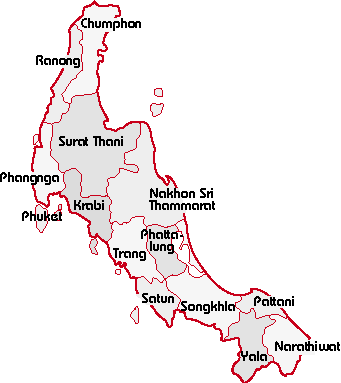|
 |
|
|
Southern Thailand consists of a long peninsula, reaching all the way down
to Malaysia. Rugged limestone mountains, covered with lush jungle, rise
along its spine, while its two coastlines - - 1,875 kilometre long on the
Gulf of Thailand and 740 kilometre on the Indian Ocean shelter countless
beaches of exceptional pristine beauty, the south also has vast plantations
of rubber, coconut, and pineapple and, near Malaysia border, a distinctive
cultural difference thanks to a largely Muslim population.
Hua hin, on the western coast of the gulf, became Thailand's first popular seaside resort in the 1920s when the southern railway line made it easily accessible to Bangkok, King Rama VII built a summer palace there, called Klai Kangwon. 'Far From Worries,' and other aristocratic families acquired properly along the scenic beach. Now the resort can boast a number of modern hotels and has spread to include nearby Cha-am, but it still has a quieter, more restful ambience than vibrant Pattaya across the gulf. Modern travellers venture further south, where they have discovered other exciting destinations. The most celebrated is Phuket, a large island in the Andaman Sea, was widely known among ancient traders for such natural wealth as tin ore and edible birds' nests harvested from limestone caves and cliffside. Phuket today, just an hourís flight from Bangkok, is famous for a string of picture-postcard beaches on its western coast, each with its own particular charms and a wide range of accommodations. Not far from Phuket is Pha Nga Bay, a marine national park, where hundreds of limestone islands rise dramatically from the sea to form a breath taking scenic spectacle, along with the equally beautiful Phi Phi islands, where turquoise waters lap the white sands of a dozen secret covers and daring sea Gypsies scale the walls of a vast, cathedral-like cave to collect the birdsí nests so prized by Chinese gourmets throughout the world. More adventurous travellers in search of unspoiled natural beauty and diving thrills can explore the Similan Islands in the Andaman Sea, a group of nine small islands off which lie countless dazzling coral reefs, or, southward near Malaysia, the huge Tarutao National Park, where 51 islands cover an area of nearly 1,500 square kilometre. Across the peninsula, off the southeast coast, lies the island of Ko Samui, a more recent tourist discovery that also offers memorable beaches fringed by graceful coconut palms and a number of smaller off-shore islands. Several southern cities such as Nakhon Si Thammarat, Chaiya, and Songkhla can look back on an ancient history, reflected in deep-seated traditions, the remains of splendid temples, and elegant old houses. Others like Hat Yai, Thailandís third largest provincial capital, have a booming modern energy fuelled by the regionís prosperity, attracting large numbers of Malaysian tourists with shops and entertainment facilities. In the southernmost provinces of Narathiwat, Pattani, Yala, and Satun, the domed mosque is as much a part of most people. Southern food is as distinctive as its scenery. Not surprisingly, the coconut, which grows so widely throughout the region, plays a prominent role in many dishes; its milk tempers the heat of chilli-laced soups and curries, its oil is often used for frying, and its grated meat serves as a condiment. Also only to be expected is the abundance of fresh seafood from the surrounding waters: marine fish, some of huge size, prawns, rock lobsters, crab, squid, scallops, clams, and mussels. Cashew nuts from local plantations are eaten as appetizers or stir-fried with chicken and dried chillies, while a pungent flat bean called sato adds an exotic, somewhat bitter flavour much admired by southern diners. Regional fruits include finger-sized bananas, mango-steens, durians, and small, sweet pineapples. Sino-Thai food is popular in most large cities; every year the large Chinese community of Phuket stages a ten-day Vegetarian Festival during October, with colourful parades as well as exotic culinary treats. Other foreign influences can be found in such dishes as kaeng matsaman, a mild Indian-style curry seasoned with cardamom, cloves, and cinnamon, several Malayan fish curries, and sate, skewered meat with a spicy peanut sauce that originally came from Indonesia. |
|
 |
|
|
|